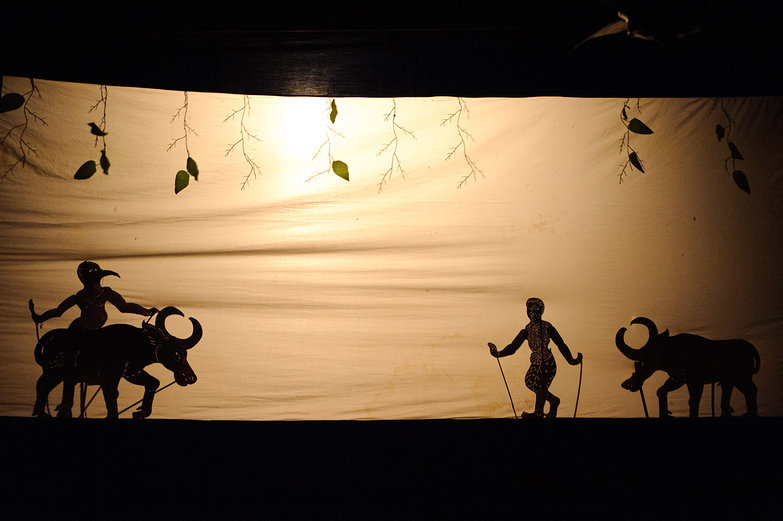For as long as I can remember, I've been fascinated by puppetry. I even worked for a short time making massive props and puppets in London at Emergency Exit Arts when I was in college. So, when we were first planning our adventure, I was naturally very excited about the opportunities we'd have to see different forms of this art, many of which still very much alive in this part of the world.
Initially, it was Vietnamese water puppetry and Javanese shadow puppetry that sparked my interest, but upon arriving in Siem Reap I have learned of a new kind. The Khmers have their own traditional style, practiced for years, called Sbaek shadow puppetry.
On our way back into town after visiting the Silk Farm the other day, we stopped in at the House of Peace Association, a shadow puppetry workshop. There, we spent a brief time learning about how the cow-skin figures are made.


Intrigued, we booked two spots at a restaurant in town that doubles as a theater for both Sbaek and traditional dances such as Apsara. The performers are kids from the NGO Krousar Thmey. All of the proceeds from ticket sales go directly to the children and the projects sponsored by this admirable-sounding organization:
First Cambodian Foundation assisting deprived children, Krousar Thmey provides deprived Cambodian children with material, educational and social support in harmony with their environment and respectful of their traditions and beliefs.
Our purpose is to help children develop and blossom into responsible adults. Krousar Thmey takes great care that its aid neither creates disharmony between a child and his relatives and friends, nor creates privileged or dependent children.
Krousar Thmey
Listening to pre-show music, we settle in at La Noria restaurant for a dinner of traditional Khmer cuisine, featuring a soup made of fish, pomelo, coconut, and tomatoes. It is a good thing we pre-booked tickets because the place is packed! A ring of tables around the small stage (the best seats in the house) is entirely occupied by a French tour group.

The lights go down, and a man introduces the troupe in both English and French, explaining that there will be three puppet shows: a traditional Cambodian folktale about two fighting monkeys, a modern parable about the dangers of gambling, and finally, the story of Sita's abduction by Ravana in the Hindu epic Ramayana.

Light comes on behind a fluttering curtain, and dark shapes of waterbuffalo appear pressed against it. The kids narrate the scenes in Khmer, so it's a little hard to tell what's going on.

I'm more interested in what the kids are doing than the show itself, so I take a peek behind the curtain.
When the shadow puppet shows are over, it's time for the dances. First is a lively dance in which the performers hold a coconut shell in each hand. As they twirl and bend and spin, they knock them with the others' shells in complicated patterns creating a catchy rhythm.


After a cute number re-enacting the movements of fishing and the courtship between fishermen and fisherwomen, the show ends with my favorite, Apsara dancing. It is performed using a delicate interplay of slow and calculated movements, a series of infinitesimally small, highly important details from the curve and articulation of a single finger to the intentional raising of the toes.

The apsara, a woodland spirit, is played by a woman, sewn into tight-fitting traditional dress, whose graceful, sinuous gestures are codified to narrate classical myths or religious stories.
Aspara Dance

Apsara dancers' fingers are extraordinarily elastic, they can bend their fingers backwards almost to the wrist.
Aspara Dance

The tradition of dance, honed for over a millennium, was almost lost in the Cambodian genocide, when the Khmer Rouge targeted those involved in the dance and "imposed a massive cultural forgetting".
Aspara Dance

With golden headdresses, thick chunky brass bracelets, pink lotus blossoms, and gorgeously ornate silk outfits… what's not to love? The art is deceptively simple, but I know it must take years and years of practice to master.

A huge thank you to reader and longtime family friend, Bill Volk, whose generous donation funded this fun cultural experience!


